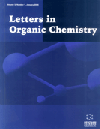- Home
- A-Z Publications
- Letters in Organic Chemistry
- Previous Issues
- Volume 21, Issue 4, 2024
Letters in Organic Chemistry - Volume 21, Issue 4, 2024
Volume 21, Issue 4, 2024
-
-
Coumarin-Derived Mannich Bases: A Review of Biological Activities
More LessAuthors: La Quy Luong and Tran Khac VuMannich bases have a distinct place in the field of medicinal and pharmaceutical chemistry. These are used as lead compounds for the synthesis of numerous heterocyclic compounds, which possess diverse biological activities and play pivotal roles. This review covers the latest literature and knowledge on Mannich bases derived from coumarin. In addition, this review also aims to provide a comprehensive overview of recent d Read More
-
-
-
Review on Pyrazole Hybrids as Anti-microbial Agents
More LessAuthors: Tanvi Goel, Naman Jain and Deepali BansodeA five-membered heteroaromatic ring with two nitrogen atoms, pyrazole, is of immense significance. Pyrazole and its derivatives are well-known nitrogen-containing heterocyclic compounds that are significant in medicinal chemistry and have a variety of biological properties, according to a thorough analysis of this class of heterocyclic lead. This article summarises some biologically active, potent pyrazole hybrids and their st Read More
-
-
-
Isatin Derivatives: A Frontier in Antimicrobial Agents
More LessAuthors: Shareef Shaik, Manish Chaudhary, Charanjit Kaur, Rajesh Kumar and Gurvinder SinghMicrobial infection is one of the major concerns for human health in the modern era. Condition is further worsening due to the development of resistance by the microbe against the available drugs. This problem can be overcome by synthesizing novel antimicrobial agents. Isatin is a promising moiety possessing antimicrobial activity. A number of isatin derivatives are present in the market for the treatment of microbi Read More
-
-
-
A Review on Diverse Biological Activity of Heterocyclic Nucleus Pyrazine and its Derivatives: A Key for the Researchers
More LessAuthors: Shilpi Pathak, Neetu Agrawal and Sonam GaurPyrazine belongs to the 1, 4-diazines family, which is a significant class of heterocyclic compounds. Various pyrazine derivatives have been produced and successfully confirmed as medicines with various pharmacological activities like anti-inflammatory, antitubercular, anticancer, antibacterial, and neurological activity, with some of them becoming clinically utilized pharmaceuticals globally. This review includes a su Read More
-
-
-
N-acetylation of Aromatic Amines by One-pot Route
More LessAuthors: Zhongqi Guo, Wenxu Fan and Keyume AblajanIn this study, a simple one-pot synthesis of acetamides from aromatic amines and acetonitrile in the presence of H2O and K2S2O8 is presented. The reaction proceeds in a mixed solvent (CH3CN: DMSO, 3:1) without using metals or toxic reagents. Various N-acetanilides are obtained with 53-91% yields. The method is selective for aromatic amines, with aliphatic amines remaining intact. This represents a new, efficient, and ec Read More
-
-
-
Study of Structural Elucidation, Degradation Kinetics and Antimicrobial Analysis of Copper (II) Sesame-Soap Complexes with Urea and Thiourea Ligand in Non-aqueous Solvents
More LessBy Asha MeenaSurfactants have great importance in biological and drug industries and the complexes of metallic soaps with various ligands are used in approximately every region of national economy. Therefore, our keen interest to study of degradation kinetics and biological importance of Cu (II) surfactants in non-aqueous and non-polar solvent benzene. Present research work has been initiated with synthesis, systematic study of Read More
-
-
-
A Convenient Synthesis of Bis-(dihydro)caffeoylspermidines
More LessAuthors: Lili He, Jian Sun, Pengjuan Zhou, Jingwen Ji, Lijuan Zhai, Dong Tang, Jinbo Ji, Haikang Yang, Zafar Iqbal and Zhixiang YangCaffeoyl spermidines are valuable alkaloids naturally existing in many plant species. These alkaloids are characterized as pharmacologically important ingredients of many plant extracts used in traditional medicines. Bis-caffeoylspermidine and bis-dihydrocaffeoylspermidine exhibit antioxidant, anti-inflammatory, and enzyme inhibition properties that make them valuable natural sources of safer therapeutic agents. Read More
-
Volumes & issues
-
Volume 22 (2025)
-
Volume 21 (2024)
-
Volume 20 (2023)
-
Volume 19 (2022)
-
Volume 18 (2021)
-
Volume 17 (2020)
-
Volume 16 (2019)
-
Volume 15 (2018)
-
Volume 14 (2017)
-
Volume 13 (2016)
-
Volume 12 (2015)
-
Volume 11 (2014)
-
Volume 10 (2013)
-
Volume 9 (2012)
-
Volume 8 (2011)
-
Volume 7 (2010)
-
Volume 6 (2009)
-
Volume 5 (2008)
-
Volume 4 (2007)
-
Volume 3 (2006)
-
Volume 2 (2005)
-
Volume 1 (2004)
Most Read This Month
Article
content/journals/loc
Journal
10
5
false
en


